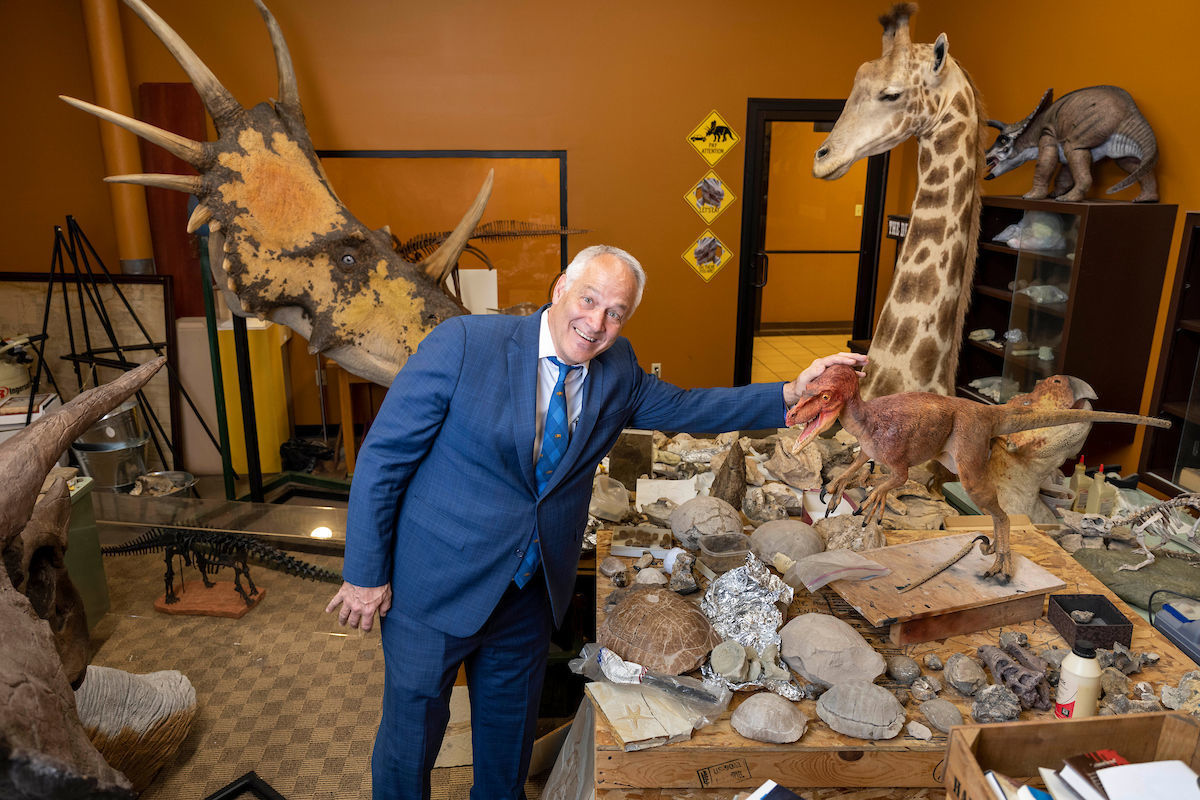 Visit South Bend Mishawaka
Visit South Bend Mishawaka
Stand on the sidewalk outside 122 South Michigan Street on a summer’s night and you’ll sense something essential and true about South Bend’s downtown revival over the past 25 years. It’s in the lilt of Don Savoie’s guitar, the glow of the brazier on the open-air patio, the laughter of children catching footballs on the artificial-turf gridiron or clinging to the life-size gorilla statue and hamming for a camera. It’s in the bustle visible inside the brightly lit café. Mostly, it’s in the exhalation of coffee and chocolate and happiness every time the café’s doors open and close, customers entering with expectation and leaving with a slice of cheesecake or an ice cream cone, or a bag of double-dipped peanuts to be devoured at home.
It isn’t hard to find longtime residents who’ll say that the South Bend Chocolate Café taught people what was possible on these once-barren city blocks, where for decades it was far more common to see a familiar but empty landmark torn down than a durable business idea sprout up. But Mark Tarner, who grew up clerking in his father’s sweet shop and launched what began as a small ice cream, coffee and chocolate store with his wife, Julie, in 1996, turns that notion around.
What’s happened since isn’t about business acumen or money or even the crafting of original and world-class chocolates, he says. Rather, people like Tarner saw something they valued in the blank marquees and cracked pavement of their old Midwestern home and refused to let it die.
“The simplicity of it,” Tarner says of the now-reborn city where he was born and raised, “is people really love this place.”
For the Clay High School alumnus, who left town to play college basketball in Illinois and study history in Germany, the past is more about continuity than change. Yes, he remembers a day when, even in their decline, the theaters were still open and the department stores made South Bend look like a “mini Chicago.” But he also greets regulars who know him as the kid who filled their orders at Sugar & Spice down the street. “The old customers say that I built on my father’s hopes and dreams,” he says.
Don Tarner taught his son a love of local history and a redoubtable work ethic that seems to have shaped every big choice he ever made. Mark and his wife, Julie, bought their first house on the city’s near west side — he says she was sold when a newel on the staircase came off in his hand, a Jimmy Stewart moment straight out of It’s a Wonderful Life.
Next door was the old Oliver mansion and, under construction, the new home of the Northern Indiana Center for History, now The History Museum. The Tarners got involved, offering everything from cash to sweat labor to the occasional Friday night case of beer, and they embraced their new neighborhood — part urban borderland and part refuge from 1980s suburbia — populated by African American families, college professors, historic preservationists, artists and artisans, aging hippies and the core of South Bend’s gay community.
They were the bridge, Mark Tarner says — change-agents like his then-neighbor Jeff Gibney, the late founding director of the South Bend Heritage Foundation, for whom “change” meant fighting the currents of urban devolution and doing instead what entrepreneurs do: taking things other people throw away and making something new with them.
Change starts at the fringe, Tarner tells his four children. It doesn’t come from a business school, but “from some liberal-arts freak who develops Facebook.”

Or, who takes a building destined for demolition and a $65,000 South Bend Heritage rehabilitation grant for exterior renovations, adds in a $1 million loan and a freaky load of DIY hours to build a chocolate café next door to a moribund chain drug store. “Now, I think they call it new urbanism,” Tarner told a reporter in 2017. “When I did it, they called it stupidity, and I think everyone thought I was going to go bankrupt.”
But by then, the Tarners were already demonstrating chocolate’s magical properties as a solvent for postindustrial soot, spalled bricks and rust. While working for his father, Tarner tested the power of brand under a licensing agreement with Notre Dame, producing simple treats sold in the campus bookstore and around town as Rocknes, Domers and Nuts for ND. He’d rented out space in a former toy factory and incorporated under the name of the South Bend Chocolate Company.
Before long, the company was known for its perfectionist renditions of the classics — malted milk balls, turtles, creams, chocolate covered nuts and berries of every imaginable kind, and coffee roasted, ground and brewed on premises — and up-to-date variations like a sea-salt caramel that is positively evil in its addictive power.
Today? “We’re kind of an innovator,” he says. “We were the first people to chocolate-stripe caramel corn commercially.”
Tarner regularly makes that kind of superlative claim, and has yet to be challenged: The first chocolate-covered dried cherry, with Michigan-based former partners Cherry Republic. The first chocolates sold in a vertical bag — which seems like a weird thing to crow about from a layman’s point of view, but apparently it was influential in the candy world because now everyone’s doing it.
One claim that hits closer to home? “World’s largest chocolate store.” It’s painted in brown, yellow, blue and white on an old-fashioned, brick-wall mural now partially obscured from the street by a new Marriott hotel. The downtown café, the flagship of a chain of more than a dozen stores, restaurants and franchise outlets in Indiana, Michigan and Ohio, was, Tarner says, “an immediate success.” He added an ice cream shop and, when the Osco drug store finally closed next door, turned the space into a deli, meeting rooms, an indoor playground, a novelty candy shop and a pretzel counter. “I don’t think there are any competitors,” Mr. World’s Largest says. “It’s over 10,000 square feet.”
The chocolate has become a kind of calling card for the city. “South Bend has a brand,” Tarner says, a blend of the local and the commercial. If it was once about an industrial past, maybe it’s now about an industrious present. Before “buy local” was hip, Tarner stamped his company out of a kind of instinctive hometown pride. “I named it classically: Where are you from, and what do you do?” he recalls.
And whether or not he knew it at the time, the label harkened back to a proud era in which nearly every business in the city was named either for its founding proprietor or the city itself. Tarner’s factory was once headquarters of the South Bend Toy Company. An 1890 bird’s-eye lithograph of the city’s prominent institutions lists South Bend Foundry, South Bend Cement, South Bend Lumber, South Bend Woolen, a South Bend National Bank, even the South Bend Medical Co., manufacturers of a “Cocaine Compound” advertised in national periodicals as a remedy for “female complaints, rectal diseases, etc.” And Pete Buttigieg, when looking for rallying symbols of a lost civic pride in his early days as mayor, settled on the sturdy and elegant pocket time-pieces produced between 1902 and 1929 by the South Bend Watch Company.
Typically, Tarner’s not the man you ask for hard figures, but he says his family-owned operation makes upwards of 500 products for thousands of wholesale customers as far away as England. You can buy “South Bend Chocolate” by name in New York and San Francisco, the company’s largest markets, and sample it at state fairs and trade shows from Indianapolis to Las Vegas. Even as the coronavirus lingers, forcing Tarner to lay off nearly 200 employees and suspend everything but his core retail operations until he could ride it out and assess the damage, he’s holding on to plans to move his factory and its modest museum of American chocolatiering to property he’s purchased near South Bend’s airport, a vision that would not only restore the lost jobs, he says, but add as many as 70 more.
“This isn’t an extinction event. This is something that will make the species stronger,” he says of COVID-19 and the quarantine. When his son, Sam, who works for the company, asked him for a recovery plan, Tarner says he wrote it down on a piece of yellow legal paper.
“Here’s my recovery plan: No rest until the closure’s over.”
He won’t deny the size or strength of his fears. His company is neither too big to fail nor small enough to benefit from the strings-attached allurements of federal relief funds. But if anything gives him courage, it’s the future of the city where he has made his living.
“This sense of place is growing. It’s almost like the 1960s were the great homogenization of our society. And we’ve gone back to really where we were from, small towns. And I think — especially since the COVID virus — I think that’s going to accelerate. Maybe not everywhere, but certainly in South Bend.”

His plans for the new factory include, bear with me, his Indiana Dinosaur Museum. About 16 years ago, responding to a challenge from his oldest daughter, Emily, who had told him that digging up dinosaur bones was impossible, Tarner took up amateur paleontology, befriended a Montana rancher — possibly with the help of some chocolate — and began amassing a collection of Cretaceous Era relics that he keeps in boxes and bins and coarse blobs of plaster and duct tape at the old factory, the café, his home and an old building on the future factory site. The collection, to which he’s added by purchase, includes most of a duck-billed Edmontosaur called Juliet that Tarner and his kids unearthed themselves.
“The vision for what’s coming together out there is very compelling,” Buttigieg told the South Bend Tribune in 2017. “Mark Tarner obviously is one of the most creative and successful people in South Bend, who believed in South Bend before many other people did.”
“I’m betting everything I’ve saved on it,” Tarner said then about the project. He envisions an all-encompassing tourist attraction, a kind of business long undervalued in a state that has conceived of itself as a bastion of agriculture and industry. Indiana Governor Eric Holcomb was scheduled to attend the groundbreaking in April, but the event was indefinitely postponed.
During a driving tour of the 88-acre property, Tarner steering his gold Hummer and wearing an Indiana Dinosaur Museum quarter-zip, he lays out a vision that includes hiking and cross-country skiing trails, a sledding hill, grazing bison, a winery, a restaurant honoring Theodore Roosevelt as the father of modern conservation, and a promontory he calls the “ND Overlook” with a view of the Golden Dome in the distance.
Live turtles outside the dino hall will converse with turtle fossils some 65 million years old on the inside, telling a story that Tarner hopes will again connect past with present.
The logic is the same as the one that built the downtown café, says the chocolate maker, bone collector and civic champion: Go where people aren’t, and give them a destination, a reason to be there. “We’re going to showcase not just dinosaurs, but life itself.”
John Nagy is managing editor of this magazine.